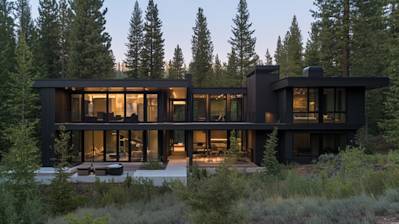California Title 24 is a term many people encounter, yet few understand its full implications. Enacted as part of the California Code of Regulations, Title 24 is a set of building standards aimed at promoting energy efficiency and ensuring that all buildings within California meet specific sustainability criteria. In this detailed guide, we'll unravel the essentials of California Title 24 and explore how it impacts construction and energy consumption in the Golden State.
What is California Title 24?
California Title 24 is a part of the California Building Standards Code, which encompasses a comprehensive set of building codes and energy efficiency standards. These regulations affect the planning, design, and construction of buildings and homes throughout the state. The ultimate goal is to create environmentally sustainable and energy-efficient buildings that help reduce energy consumption and greenhouse gas emissions.
The Origins of Title 24
The roots of Title 24 date back to 1978 when the California Legislature enacted the legislation in response to the energy crisis of the era. Over the years, Title 24 has evolved, with regular updates ensuring it aligns with the state’s ambitious environmental goals. These updates, usually occurring every three years, incorporate new technological advancements and insights on energy efficiency.
Key Components of Title 24
Title 24 is divided into various parts, each addressing different aspects of building and energy standards. Here’s a closer look at some of its main components:
Part 6: Energy Efficiency Standards
One of the most crucial parts of Title 24 is Part 6, which specifically deals with energy efficiency standards. Part 6 applies to residential and non-residential buildings and sets forth requirements on:
- Insulation: Ensures adequate thermal resistance in buildings to reduce cooling and heating demands.
- Lighting: Encourages the use of energy-efficient lighting systems, including LEDs and smart lighting technologies.
- Ventilation: Mandates mechanical ventilation systems to improve air quality and reduce pollutants.
- HVAC Systems: Calls for energy-efficient heating, ventilation, and air conditioning systems.
Part 11: CALGreen
Part 11, commonly known as CALGreen, is California's Green Building Standards Code. It establishes regulations for sustainable construction practices, ensuring buildings:
- Use less energy and water.
- Generate less waste.
- Are healthier and more comfortable for occupants.
CALGreen provides both voluntary and mandatory measures that encourage green construction initiatives such as recycling construction debris, improving indoor air quality, and installing water-efficient fixtures.
Impacts on Construction and Development
Residential Impacts
For homeowners and builders, understanding Title 24 is crucial for ensuring compliance while maximizing energy efficiency. Residential compliance includes requirements such as:
- Using high-performance windows and daylighting strategies.
- Installing solar-ready roof design for new constructions.
- Implementing thermal mass designs to optimize heating and cooling.
Commercial Impacts
For commercial buildings, Title 24 compliance includes the integration of renewable energy sources and energy-efficient technologies. Key focus areas include:
- Building envelope enhancements to minimize energy losses.
- Implementing demand-controlled ventilation to reduce energy use.
- Utilizing advanced lighting controls and energy management systems.
How to Achieve Title 24 Compliance
Achieving Title 24 compliance involves careful planning, design, and execution. Here are some steps to guide the process:
Pre-Design Phase:
- Conduct a thorough site analysis to understand local climate and environmental conditions.
- Involve energy consultants early to map out efficient design strategies.
Design Phase:
- Use building simulation software to evaluate energy performance.
- Select energy-efficient materials and technologies.
Construction Phase:
- Monitor construction to ensure all systems and materials align with Title 24 standards.
- Document and verify each stage to facilitate smooth inspections.
Post-Construction:
- Perform commissioning to ensure all systems operate efficiently.
- Opt for routine maintenance to uphold energy efficiency.
Benefits of Complying with Title 24
Complying with California Title 24 provides numerous benefits for builders, homeowners, and the environment:
- Reduced Energy Costs: Energy-efficient designs and systems lead to lower utility bills.
- Environmental Stewardship: Reduced carbon footprint and conservation of natural resources.
- Enhanced Comfort and Health: Improved air quality and thermal comfort for building occupants.
- Increased Property Value: Energy-efficient buildings are more attractive to buyers and tenants, increasing resale and rental value.
Key Considerations
- Stay Updated: Title 24 regulations undergo periodic revisions, so it is essential to stay informed about the latest updates.
- Professional Guidance: Engage with experienced architects, engineers, and energy consultants familiar with Title 24 requirements.
- Incentive Programs: Explore state and local incentive programs that may offer financial support for compliant constructions.

Frequently Asked Questions About California Title 24
How does California Title 24 impact new construction projects?
California Title 24 significantly impacts new construction projects as it sets the energy efficiency standards they must meet to reduce energy consumption. All new buildings, whether residential or non-residential, must adhere to these rigorous standards. The goal is to minimize the environmental footprint of new developments by implementing energy-efficient building methods and materials. These regulations require the integration of energy-saving measures such as high-performance windows, improved insulation, energy-efficient lighting, and advanced HVAC systems. By meeting Title 24 requirements, new projects not only adhere to the law but often realize long-term cost savings through reduced energy bills.
Are existing buildings affected by Title 24?
Yes, existing buildings are also affected by California Title 24 standards. When an older building undergoes renovations or significant upgrades, it must comply with the energy efficiency requirements relevant to the scope of the work. This means that if you are modifying systems like HVAC, insulation, or lighting, you must retrofit these components to meet current Title 24 standards. The primary aim is to improve the energy performance of older buildings and bring them closer to the efficiency levels of new constructions, ultimately contributing to statewide energy conservation goals.
What is the purpose of California Title 24 energy codes?
The purpose of California Title 24 energy codes is to regulate energy consumption and promote sustainability in building design and construction. The energy codes focus on increasing energy efficiency to reduce unnecessary energy use, lower utility costs, and decrease greenhouse gas emissions. By setting stringent efficiency guidelines, Title 24 supports California’s broader environmental objectives, including reducing reliance on fossil fuels, enhancing air quality, and mitigating climate impact. This regulatory approach encourages the development of greener buildings that benefit the environment and occupants alike.
How often is Title 24 updated?
California Title 24 is updated every three years to stay aligned with the latest technological advancements and environmental goals. The updates are conducted by the California Energy Commission, which reviews and revises the standards to incorporate cutting-edge innovations and respond to evolving energy challenges. With each update, more stringent requirements may be introduced to further reduce energy consumption and improve building efficiency. The triennial update process ensures that California remains at the forefront of sustainable building practices and energy conservation.
What happens if a project does not comply with Title 24?
Non-compliance with California Title 24 can lead to significant penalties and project delays. Building permits may be denied, and the project could be halted until the necessary adjustments are made to meet the energy standards. In some cases, financial penalties might be imposed for non-compliance. Therefore, it is crucial for architects, builders, and developers to thoroughly understand Title 24 requirements during the design and planning stages to ensure compliance. Working with knowledgeable professionals who are familiar with the regulations can help avoid these issues and ensure a smoother approval process.
Can homeowners make changes to their home without considering Title 24?
Homeowners can make changes to their homes, but depending on the scope of the changes, they may need to comply with Title 24 energy standards. For minor repairs or aesthetic changes that do not impact the building's energy systems, Title 24 compliance may not be necessary. However, for larger projects such as adding rooms, replacing HVAC systems, or altering the building envelope, homeowners must ensure these changes comply with the current energy efficiency standards. This is to promote enhanced energy performance and utility savings while contributing to California's environmental goals.
What are the costs associated with complying with Title 24?
Complying with California Title 24 can involve initial upfront costs, such as upgrading building materials and systems to meet the energy efficiency standards. However, these costs are often offset by long-term savings on energy bills, as efficient buildings consume less energy. It is also important to consider that investing in compliance can increase property value through enhanced performance and sustainability credentials. Homeowners and developers might also explore incentives or rebates available for implementing energy-saving technologies, which can help offset some of the initial expenses.
How does Title 24 affect commercial buildings?
Title 24 has a substantial impact on commercial buildings by setting specific energy efficiency standards that these structures must adhere to. Commercial buildings must incorporate energy-saving designs and technologies that may include advanced lighting systems, efficient heating and cooling systems, and the use of renewable energy sources. These regulations aim to significantly reduce energy consumption in commercial spaces, which are typically higher energy users than residential buildings. By meeting Title 24 standards, commercial buildings can reduce operational costs and support California’s broader energy and environmental goals.
Is solar energy mandatory under Title 24?
While solar energy is not explicitly mandated for all buildings under Title 24, recent updates have increased the emphasis on renewable energy options. For new residential constructions, the standards do consider solar readiness as a key component of meeting energy efficiency benchmarks. Incorporating solar panels can help meet or exceed the energy efficiency requirements set forth by Title 24. Utilizing solar energy is encouraged as a means to further reduce dependency on non-renewable resources and contribute to the state’s clean energy targets, aligning with broader sustainability efforts.
What role does technology play in meeting Title 24 requirements?
Technology plays a crucial role in meeting California Title 24 requirements. Advanced building technologies, such as smart lighting controls, high-efficiency HVAC systems, and energy management systems, facilitate compliance with Title 24 by optimizing energy use. These technological solutions can be integrated into building design to monitor and adjust energy consumption in real-time, ensuring ongoing adherence to energy efficiency standards. Furthermore, incorporating modern technology allows for ongoing improvements in building performance and energy savings, aligning with the evolving Title 24 mandates.

Standards & Regulations
Relevant Building Codes
Title 24 is part of the California Code of Regulations and mainly involves the Building Energy Efficiency Standards. These standards apply to both residential and nonresidential buildings, aiming to reduce wasteful, uneconomic, and unnecessary energy consumption. The California Energy Commission updates these codes every three years to ensure they encapsulate the latest technological innovations and environmental mandates. Building codes cover everything from lighting and ventilation to insulation and weatherproofing, requiring that all aspects align with energy-saving practices.
Legal Requirements
Adhering to Title 24 is not merely a suggestion—it's a legal obligation if you're involved in construction or renovation projects in California. The legal requirements impinge on various stakeholders, including architects, builders, and even homeowners. Among the critical mandates is incorporating energy-efficient materials and methods, like high-performance windows and advanced HVAC systems, to not just tick the compliance box but also contribute to environmental sustainability.
Industry Standards
Title 24 has become an industry benchmark, shaping construction practices far beyond California. The standards encourage using green building materials, lean construction methodologies, and energy modeling techniques, setting an example that ripples across states and even influences national standards. Builders frequently refer to benchmarks like LEED (Leadership in Energy and Environmental Design), which align closely with Title 24 objectives, thus ensuring consistency with recognized industry norms.
Permit Requirements
Before a shovel hits the dirt, Title 24 compliance must be confirmed through a comprehensive permitting process. Local enforcement agencies review plans and calculations to confirm that a proposed building project meets or exceeds the necessary standards. This review includes scrutinizing building envelopes, mechanical systems, and lighting designs, ensuring all elements align with Title 24 mandates. Only after securing a permit can construction commence, embedding compliance from the outset.
Compliance Considerations
Successfully navigating the compliance maze of Title 24 requires a strategic and informed approach. Factors such as building orientation, climate zone classification, and local environmental considerations come into play. To streamline compliance, tools like energy compliance software (e.g., EnergyPro or CBECC-Com) help in conducting performance assessments. For builders and designers, foresight in these areas saves time and curtails headaches during approval phases.
Warranty/Insurance Implications
Title 24 compliance plays into insurance and warranty realms as well. A building conforming to the latest standards is generally seen as less of a risk by insurers, possibly resulting in more favorable insurance premiums. Moreover, non-compliance can lead to potential legal and financial liabilities, affecting warranties not just from a builder's perspective but also for product manufacturers. Ensuring that products and construction techniques adhere to Title 24 limits the likelihood of post-construction claims and disputes, safeguarding all involved from unwanted litigation or financial burdens.

Final Thoughts
Understanding California Title 24 is essential for any homeowner looking to make efficient and compliant upgrades to their property. Whether you're considering energy-efficient windows, insulation, or HVAC systems, these regulations set the standard for reducing energy consumption and enhancing comfort. By following these guidelines, you ensure not only compliance but also contribute to a more sustainable future.
If you're ready to take the next step towards improving your home's energy efficiency, we’re here to help. At GVD Renovations & Remodeling, we specialize in providing tailored solutions for homeowners in Northern California. Feel free to reach out to us for a consultation or to request a free estimate—we’d love to guide you through the process and make your renovation dreams a reality.
This article is for general information only and not professional advice. Always consult a licensed contractor before making project decisions. Product details, specifications, or warranties may have changed since publication. Brand and product mentions reflect opinion, not endorsements or guarantees.
Tags: building codes, energy efficiency, construction regulations,


















